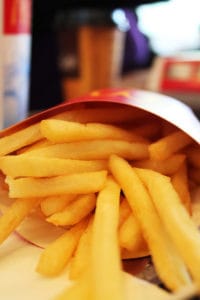Cornucopia’s Take: The sole purpose of food coloring is to improve the aesthetics of food. While American food companies ply our kids with petrochemicals and other toxins, they are selling cleaner versions of their products in Europe.
The best way to avoid harmful ingredients is to buy organic!
Food Doesn’t Have to Wear Makeup
Food coloring has no purpose and plenty of negatives. We only allow it still because the system is broken.
Slate
by Shilpa Ravella
 |
In Britain, McDonald’s fries have four ingredients: potatoes, vegetable oil, dextrose, and salt. In the U.S., McDonald’s fries have a whopping 19 ingredients—including sodium acid pyrophosphate, which keeps the fries’ color from getting dull. This is strange since you’d think that all we really expect of French fries is for them to at least vaguely mimic the color of a potato. Then there’s McDonald’s strawberry sundae. In Britain’s version, all the color comes from real strawberries. In the U.S., we use Red No. 40. This plays out beyond the fast food chain: For example, Starburst fruit chews are colored with carotenes and chlorophylls across the Atlantic but with Red No. 40 and Yellow No. 6 in the U.S. Many major food companies in the U.S. use artificial food dyes in America—while selling naturally colored or dye-free versions in Europe.
Chemicals like Red No. 40, Yellow No. 5, and Blue No. 1 make American food look better. These additives are the culinary equivalents of lipstick and mascara, and they are often made from the same pigments. Making food pretty has become the status quo in the U.S., but it’s not doing us any good: Not only does it trick us into thinking some foods are healthier than they are, but the dyes themselves may be harmful. So why do we use keep using these dyes when so many other countries manage without them?
It wasn’t always this way. Until the mid-19th century, natural food dyes from plants, animals, and minerals were used to color food in the U.S. Things changed when companies discovered artificial dyes which were cheaper, brighter, and more stable than their natural counterparts. Artificial dyes made food look more attractive, which made them popular with consumers. America is a relatively young and expansive country, and a major historical concern involved feeding a growing population while moving food large distances. Food was treated like a commodity, with market forces shaping what were most valued: cost, convenience, and appearance. For decades, there was little push to fret—as Europeans did—about what was actually in our food. We just wanted it to look good.
Read the entire article.

